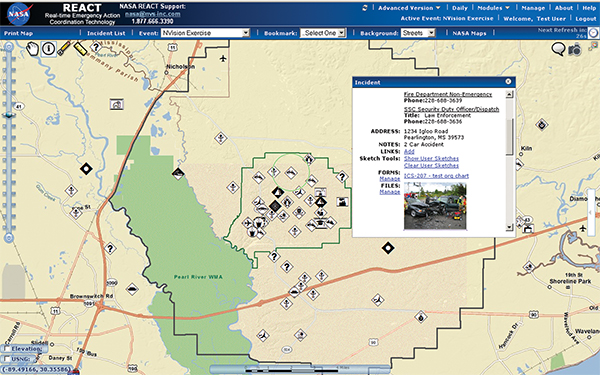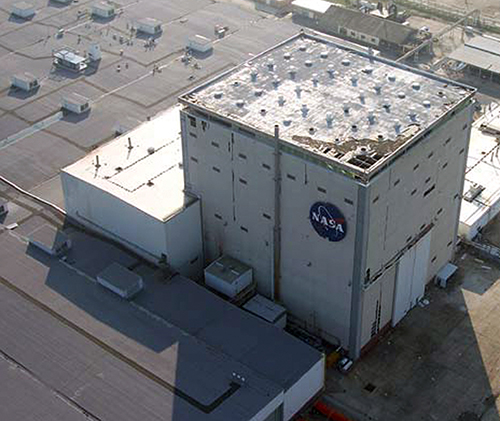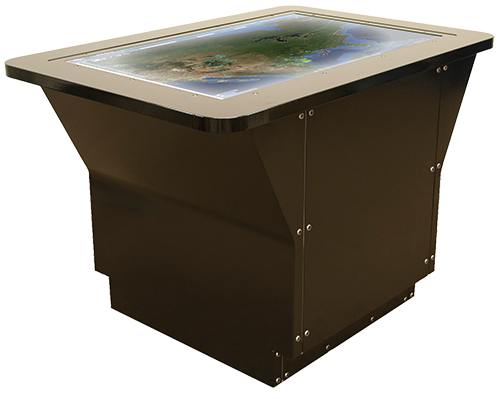
Information Systems Coordinate Emergency Management
NASA Technology
The rescue crews have been searching for the woman for nearly a week. Hurricane Katrina devastated Hancock County, the southernmost point in Mississippi, and the woman had stayed through the storm in her beach house. There is little hope of finding her alive; the search teams know she is gone because the house is gone.
Late at night in the art classroom of the school that is serving as the county’s emergency operations center, Craig Harvey is discussing the search with the center’s commander. Harvey is the Chief Operating Officer of a unique company called NVision Solutions Inc., based at NASA’s Stennis Space Center in Bay St. Louis, only a couple of miles away. He and his entire staff have set up a volunteer operation in the art room, supporting the emergency management efforts using technology and capabilities the company developed through its NASA partnerships. As he talks to the commander, Harvey feels an idea taking shape that might lead them to the woman’s location. Working with surface elevation data and hydrological principles, Harvey creates a map showing how the floodwaters from the storm would have flowed along the topography of the region around the woman’s former home.
Using the map, search crews find the woman’s body in 15 minutes.
Recovering individuals who have been lost is a sad reality of emergency management in the wake of a disaster like Hurricane Katrina in 2005. But the sooner answers can be provided, the sooner a community’s overall recovery can take place. When damage is extensive, resources are scattered, and people are in dire need of food, shelter, and medical assistance, the speed and efficiency of emergency operations can be the key to limiting the impact of a disaster and speeding the process of recovery. And a key to quick and effective emergency planning and response is geographic information.
With a host of Earth-observing satellites orbiting the globe at all times, NASA generates an unmatched wealth of data about our ever-changing planet. This information can be captured, analyzed, and visualized by geographic information systems (GIS) to produce maps, charts, and other tools that can reveal information essential to a wide variety of applications—including emergency management. Knowing precise, real-time information about the size, location, environmental conditions, and resulting damage of an event like a flood or wildfire—as well as the location and numbers of emergency responders and other resources—contributes directly to the effectiveness of disaster mitigation. The need for such information is also evident when responding to homeland security threats, such as a terrorist attack.
Recognizing the value of its geospatial information resources for this and other purposes, in 1998 Stennis and the state of Mississippi partnered to form what became the Enterprise for Innovative Geospatial Solutions (EIGS) industry cluster, supporting the growth of remote sensing and GIS-based research and business. As part of EIGS, several companies partnered with NASA through dual use and Small Business Innovation Research (SBIR) contracts. Among those was NVision.
Partnership
Founded in 2002 through a technology incubator under EIGS, NVision sought to capitalize on the geospatial information Stennis could offer.
“We started the company with two people in an empty office, no money, and a single piece of paper with a logo we thought looked cool,” says Harvey. “We were local people who saw the opportunity.” The opportunity, he explains, was employing NASA’s constantly updated geographic data to provide essential, practical information to users in real time.
NVision—a minority, woman-owned firm—engaged with Stennis through multiple dual-use and SBIR projects. An initial outcome was a precision agriculture system that harnessed NASA satellite data, research, and algorithms to allow farmers to generate efficient strategies for treating crops with fertilizers, pesticides, and other crop control chemicals. (The technology was commercialized through InTime Inc. of Cleveland, Mississippi—another NASA partner with origins at Stennis.) That work found a new application in 2003, when Louisiana’s St. Tammany parish suffered flooding in the wake of Tropical Storm Bill. To answer the parish’s need for more efficient acquisition of flooding estimates and damage assessments, NVision applied elements of its precision agriculture system to create a real-time flood alert system—a system the parish still uses today. With additional NASA assistance, the company further developed the St. Tammany emergency response system and realized the significance of this new direction.
“We didn’t have that much farther to go to have a comprehensive emergency management system,” Harvey says. This was the beginning of NVision’s Real-Time Emergency Action Coordination Tool (REACT).
When Hurricane Katrina struck the Gulf Coast in 2005, NVision immediately volunteered its GIS-based emergency management expertise to assist in Hancock County’s recovery efforts. Using NASA data from Stennis, the company churned out thousands of unique, custom maps per week to support emergency operations needs. The experience the company gained during Katrina translated into even more robust, comprehensive emergency management capabilities. (The solution Harvey devised to find the missing woman, for example, became a search and rescue tool now used as standard practice on the Gulf Coast.)
When Stennis constructed a new emergency operations center following Katrina, NVision tailored its REACT system to NASA’s specifications. The NASA-derived technology ended up perfectly suiting NASA’s own needs, says Ron Magee, emergency director at Stennis.
“The REACT system pulls from our GIS systems so it has the most current mapping and data layers that are associated with geographic coordinates,” he explains. “It gives us a one-stop shop where we can have all of the information at our fingertips.”
Those capabilities impressed emergency managers at other NASA centers, and through a Phase III SBIR agreement, the REACT system was established at NASA Headquarters and every NASA center nationwide, allowing the Agency to launch coordinated responses in the event of an emergency situation.
Benefits
NASA, however, is far from the only beneficiary of the REACT technology. Today, REACT is NVision’s flagship product and has resulted in more than $2 million in revenue. Recently designated by the Department of Homeland Security (DHS) as a Qualified Anti-Terrorism Technology, REACT is currently in use by varied organizations throughout the country for a broad spectrum of emergency management applications.
Simply put, REACT is a Web-based information system for enhancing decision making before, during, and after emergency situations.
“REACT looks at an emergency in a comprehensive way,” Harvey says. “What sets it apart is that it is all handled with a geospatial perspective.” Accessible through any computer and even handheld devices for use by emergency workers in the field, the system provides a Common Operating Picture combining everything from water levels to the location of police cars to the number and current capacity of shelters and hospitals, and more—all in real time. “We’ve got satellites, river gauges, housing data, tax base data, elevation data,” says Harvey.
REACT also functions as an effective emergency management training tool and, in nonemergency circumstances, as a facility management system for running the day-to-day operations of a building or campus. Incorporating the DHS National Incident Management System and Incident Command System, REACT even encompasses standardized government elements such as forms, allowing officials to quickly access and complete necessary paperwork. The goal is to provide emergency managers with all of the tools for making and executing informed decisions, even under duress.
“It really boils down to this: Quicker, more efficient decisions save lives,” Harvey says.
REACT has been used for emergency response to Hurricanes Ivan, Katrina, Gustav, and Ike. The Hancock County Emergency Operations Center, Mississippi National Guard, and the Environmental Protection Agency used the system during the 2010 Deepwater Horizon oil spill, tracking the extent of the spill, the location of oil booms, and air and water quality monitoring efforts. The National Center for Spectator Sports Safety and Security employs REACT as a counterterrorism solution for large stadiums and venues, and the U.S. Navy’s Center for Asymmetric Warfare has standardized the NASA-derived technology for use during its large scale military training exercises. The benefits to these and other REACT users include significant cost reductions; Harvey notes that the U.S. Coast Guard has recognized multimillions of dollars in savings from response initiatives employing the REACT system.
The company has also developed new technologies in support of REACT, including a touchscreen tabletop device that allows REACT users to easily access and manipulate the information the system provides. The technology has attracted attention for uses beyond REACT, including military command briefings in the field, and has generated about $500,000 in revenue for the company.
NVision now expects REACT to become a national standard within 5 years.
“We’re talking with other states now that are looking to deploy REACT at state or regional levels,” Harvey says. “It’s been a long haul to get this credibility. It’s what NASA brings to the table for us.” Harvey notes that while the company started in 2002 with no investment, by 2008 it employed 52 workers. That number is now close to 75, and the company offers an average salary of $60,000.
“These are Mississippi people getting high-tech jobs to support NASA Stennis initiatives,” Harvey says.
In the meantime, the EIGS cluster Stennis helped to found recently became a wholly private, self-funded venture, managed by the Magnolia Business Alliance. NVision is a leader of the alliance, which will support the ongoing growth of the Mississippi geospatial industry.
“NASA was financially supporting development, lowering the barriers of high tech companies to get involved in geosciences, and creating a service industry for the commercial remote sensing program at Stennis,” Harvey says. “It worked.”
In the meantime, Stennis is now better equipped in the event of another disaster on the magnitude of Hurricane Katrina.
“We’re pretty much whole again and prepared for the next storm,” says Magee. “REACT is a part of that.”

NVision Solutions Inc.’s NASA-derived REACT system provides officials with information on everything from the number and location of emergency workers to shelter capacities to water levels—through any computer and even handheld devices in the field.

Hurricane Katrina caused damage to NASA facilities, including Stennis Space Center and the Michoud Assembly Facility, pictured here.

NVision developed its touchscreen tabletop technology to support its REACT system, but the technology’s applications extend beyond this original purpose.

NASA’s comprehensive satellite data is an invaluable tool for emergency management. Here, the progression of Hurricane Katrina in 2005 is imaged using NASA satellite data.













